In today’s vast technology landscape, there are two vital yet often overlooked components: firmware and firmware engineering. But what are they? Many people are still unaware of them.
In fact, they are the backbone of various electronic devices we use daily. Moreover, they quietly ensure that those gadgets function smoothly.

While hardware and software grab all the attention, firmware engineering quietly connects the physical parts with the software they need to work.
In this blog, let’s look at the importance of firmware engineering, its impact on our daily lives and devices, and its immense potential in shaping the future of technology and innovation. Let’s dive in.
What exactly is a firmware?
Firmware programs a hardware device’s non-volatile memory, ensuring it retains its content even when the device is turned off. It’s installed directly onto the hardware during manufacturing and is essential for running user programs and enabling the hardware to function.
Key Points About Firmware to Remember:
- Firmware is the basic software that makes hardware devices function.
- It stays in memory, which keeps data even when the device is turned off.
- Also, Firmware controls essential devices’ operations, ensuring they work correctly.
- Firmware is embedded in many devices, even in everyday items like phones, TVs, appliances, and cars.
- Also, firmware is not meant to be frequently updated or changed, unlike regular software.
- Moreover, Firmware is occasionally updated to fix security issues or add new features, often done remotely through Firmware Over-The-Air (FOTA) updates.
- Foundation Layer: Acts as the foundation for other software and applications to run on a device.
What are the three major types of firmware?
There are numerous types of technology-specific firmware, but all firmware can be broadly classified into three categories based on the level of hardware integration.
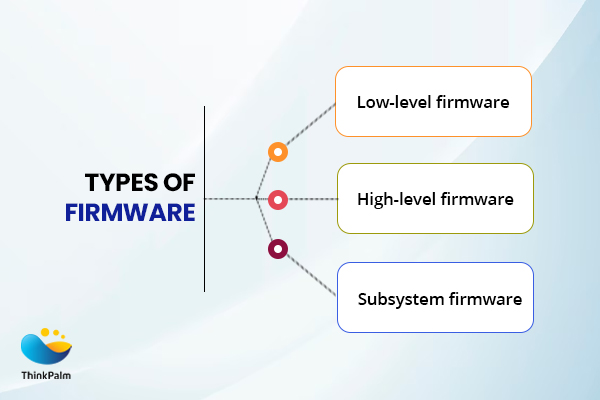
1. Low-level Firmware:
- It is built into device hardware and stored on read-only chips like ROM.
- Characteristics: Can’t be changed or updated; essential for basic functions.
- Example: BIOS in computers, controlling basic hardware functions.
2. High-level Firmware:
- It is more complex and stored on flash memory chips.
- Characteristics: Allows updates; adds new features and improvements.
- Example: Computer firmware used for BIOS updates that enhance performance.
3. Subsystem Firmware:
- It’s part of embedded systems, comparable to high-level firmware.
- Characteristics: Updatable; provides specialized functionality.
- Example: Firmware for a server’s power subsystem, enabling independent power management.
What is firmware engineering?
Firmware engineering is all about creating and managing the software that’s built into (embedded) hardware devices. This software, known as firmware, is integral to the functioning of various devices, from household appliances to complex machinery. Therefore, you can think of it as the software that runs directly on things like your smartphone, your smartwatch, your microwave, or even your car!
What does a firmware engineer do?
Firmware engineers make sure the software works well with the device’s hardware, making it run smoothly and do what it’s supposed to do, all while making it as efficient as possible.
Here’s a simpler breakdown for better understanding:
- Writing Code for Hardware: Firmware engineers write code that controls the basic functions of hardware components, like turning on a light or reading data from a sensor. For instance, if you have a smart light bulb, firmware engineers write the code instructing the light bulb to turn on, change colors, or adjust brightness levels.
- Making Sure It Works Well: They ensure this code works smoothly with the hardware it controls so your devices function properly.
- Optimizing Performance: They also work to make the code efficient, so it doesn’t waste resources like memory or processing power.
- Fixing Problems: If there are issues with how the hardware and software interact, firmware engineers fix them.
- Updating and Improving: They’re also responsible for updating and improving the firmware over time, adding new features, and fixing any bugs that pop up.
In short, firmware engineering is all about making sure the software in your gadgets works just right!
What are the top applications of firmware?
Firmware is used in many types of devices, including some that you might not think of as computing equipment. Here are some common applications:
1. Personal Computers:
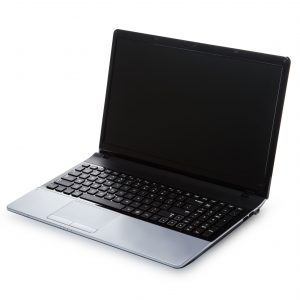
- The firmware in PCs, such as BIOS or UEFI, resides in a memory chip embedded in the motherboard.
- BIOS helps the computer boot up and manage hardware components. Graphics and video cards also have firmware.
2. Storage Devices:
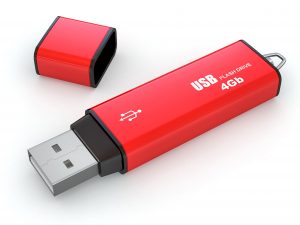
- USB drives, hard drives, and other storage devices have firmware to enable them to work with computers.
- Firmware in a USB drive allows it to store and transfer data.
3. Mobile Devices:

- Phones, tablets, and laptops have firmware that helps the hardware interact with the software.
- Firmware in a smartphone manages the camera, touch screen, and network connectivity.
4. Automotive:

- Cars have many embedded systems and sensors with firmware to perform specific tasks.
- Firmware in antilock braking systems (ABS) ensures proper braking.
5. Home Appliances:

- Appliances like dishwashers and washing machines have firmware to control their functions.
- Firmware in a washing machine manages washing cycles and settings.
6. Smart Cards:

- Smart cards have embedded firmware for basic functions, authentication, and encryption.
- Firmware in a smart card enables secure transactions and access control.
Firmware is crucial for the proper functioning of all these devices to ensure they are operating correctly and efficiently.
What is the difference between firmware engineering and embedded engineering?
In simple terms:
- Firmware Engineer: They create specialized software (firmware) that’s like the brain of devices such as your garage door, your remote, or even your car brakes. Also, they write rules/algorithms for how these devices should work, needing skills in programming and understanding hardware.
- Embedded Software Engineer: They make the software that runs electronic devices like smartphones or GPS systems. Therefore, they need to know programming languages and should understand hardware. On top of all, they design, develop, test, and maintain these systems to ensure they work smoothly and efficiently.
What is FOTA?
FOTA stands for Firmware Over-the-Air. It allows manufacturers to send firmware updates to devices wirelessly. This means you don’t have to connect your device to a computer or do anything manually. Your device updates itself, keeping it current with new features and security fixes.
Recent Updates in FOTA Technology
Here are a few recent updates that make FOTA updates safer, quicker, and easier for everyone:
- Better Security: Updates are now more secure, protecting your device from unauthorized access.
- Smaller Downloads: Only the changed parts of the firmware are downloaded, saving data and time.
- More Reliable: If an update fails, the device can go back to the previous version to prevent problems.
- More Devices Supported: FOTA is now used in many devices, not just smartphones, like smart home gadgets and cars.
- Clear Notifications: Devices now give better information about updates, so you know what’s being changed and why.
- Smart Timing: Updates can happen when you’re not using your device to avoid disruptions.
- Thorough Testing: Updates are tested more thoroughly before being sent out to ensure they work well on all devices.
What are the top six firmware development approaches?
There are several major approaches to consider when developing firmware. Each approach offers unique advantages tailored to various project types and requirements. Here are the major firmware development approaches:
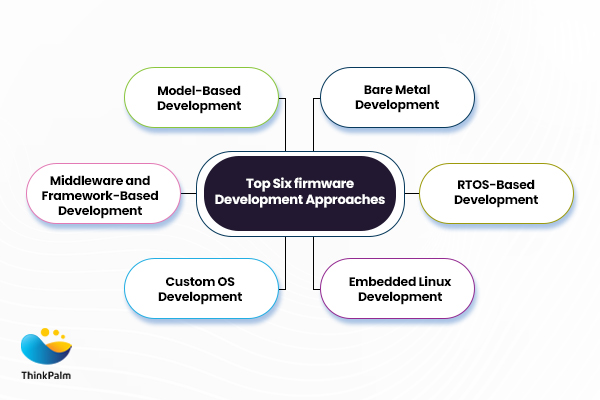
1. Bare Metal Development:
Bare Metal Development involves writing firmware directly for hardware without using an underlying operating system.
- Advantages: Maximum performance, less memory use, precise timing control.
- Best for: Simple or time-sensitive tasks like small embedded systems.
2. RTOS-Based Development:
RTOS-Based Development involves using a Real-Time Operating System (RTOS) to efficiently manage and execute tasks with precise timing.
- Advantages: Easier task management, better multitasking, scalability.
- Best for: Complex tasks needing multitasking and real-time performance, like automotive or medical systems.
3. Embedded Linux Development:
Embedded Linux Development involves using a complete operating system, such as Linux, for embedded systems.
- Advantages: Access to many features, easier networking, robust file system.
- Best for: Feature-rich applications like smart devices or multimedia systems.
4. Custom OS Development:
Custom OS Development is all about crafting a specialized operating system that perfectly fits the needs of a specific device.
- Advantages: Highly optimized, custom features, fine control over resources.
- Best for: Unique needs not met by existing systems.
5. Middleware and Framework-Based Development:
Middleware and Framework-Based Development involves using pre-built software components or frameworks to handle common tasks or services within a project.
- Advantages: Faster development, code reuse, easier maintenance.
- Best for: Projects benefitting from pre-built components, like IoT devices.
6. Model-Based Development:
It’s the process of designing and testing firmware using models prior to coding.
- Advantages: Early validation, automatic code generation, precise design.
- Best for: Safety-critical systems or precise behavior modeling, such as in automotive control.
How do you choose the right firmware development approach?
Each approach has its strengths, and the best choice depends on your project’s goals and constraints. So, when selecting a firmware development approach, consider the following:
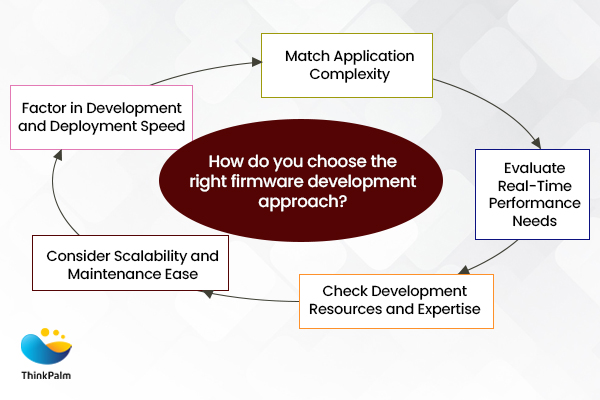
- Complexity: Ensure the approach matches the complexity and needs of your application.
- Performance: Evaluate if real-time performance and resource constraints are essential for your project.
- Resources: Assess the availability of development tools, libraries, and expertise needed for the chosen approach.
- Scalability and Maintenance: Think about how easily the firmware can be updated and maintained in the future.
- Time-to-Market: Consider the development time and speed of deployment required for your project.
Frequently Asked Questions
Why do you need to create a firmware?
You need to create firmware to control and manage the hardware functions of a device.
What is firmware & kernel development?
Firmware and kernel development is about writing software for device functionality and core operations.
Are firmware engineers in demand in 2026?
Yes, industries will highly seek firmware engineers in 2026, maintaining their demand across various sectors and offering attractive packages.
What is the future of firmware engineers?
It seems really promising with the increasing complexity of embedded systems.
How does ThinkPalm support OEMs in firmware development?
ThinkPalm pioneers tailored solutions for OEMs in firmware development, leveraging cutting-edge networking and wireless technologies such as Wi-Fi 7, Wi-Fi 6E, Wi-Fi 6, Wi-Fi 5, 2.4 GHz, and 5GHz. Our expertise spans firmware engineering, RDK-B development and integration, Wi-Fi Hardware Abstraction Layer (HAL) development, and product engineering.
Further, we assist OEMs by providing robust Wi-Fi solutions for access points and stations, prioritizing network deployment for enhanced broadband experiences, and improving connectivity with Wi-Fi HAL development. Additionally, our services include tailored application and firmware development, efficient Wi-Fi driver crafting, Bluetooth Low Energy integration, seamless Wi-Fi protocol integration, and cloud-based network management solutions. Also, we excel in effective network equipment management.
Moreover, we’re dedicated to reducing time-to-market and minimizing risks, whether for Industrial Internet of Things (IIoT) projects or comprehensive software framework development. We also specialize in fast, secure, real-time data sharing and hassle-free platform development.
So, with ThinkPalm, OEMs can rely on our expertise in Wi-Fi HAL development, RDK-B development, and integration to revolutionize their wireless software development journey.

Author Bio
Vishnu Narayan is a dedicated content writer and a skilled copywriter working at ThinkPalm Technologies. More than a passionate writer, he is a tech enthusiast and an avid reader who seamlessly blends creativity with technical expertise. A wanderer at heart, he tries to roam the world with a heart that longs to watch more sunsets than Netflix!
